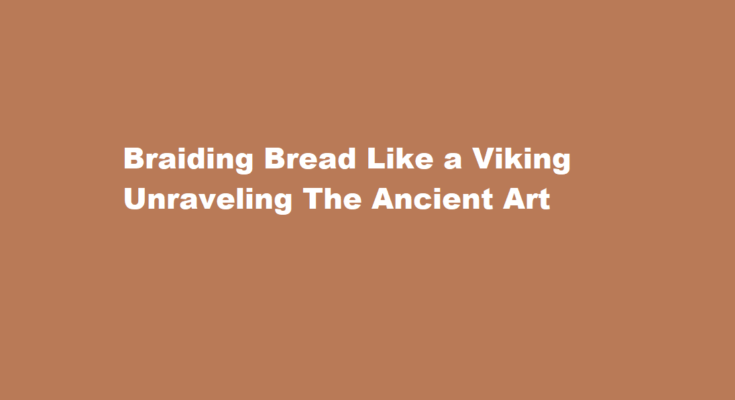Introduction
Baking bread has been a fundamental culinary tradition for centuries, and the Vikings were no exception. Their mastery of bread-making techniques, including the art of braiding bread, has left a lasting legacy that continues to inspire bakers today. In this article, we will delve into the fascinating world of Viking bread-braiding, exploring the techniques, ingredients, and history that make it a unique and rewarding endeavor.
The Viking Bread Legacy
The Vikings, known for their seafaring prowess and warrior spirit, had a rich culinary tradition that extended far beyond their battlefields and longships. Bread was a staple in their diet, providing sustenance during their epic voyages and daily life. Viking bread was often a simple yet hearty creation, crafted from the limited resources available during their time.
Braiding bread was a method employed by the Vikings to enhance the flavor and appearance of their loaves. The act of weaving strands of dough together not only made the bread more visually appealing but also contributed to its texture and taste. To recreate this ancient art in your modern kitchen, let’s explore the steps involved.
Ingredients You’ll Need
1. Flour The Vikings used a variety of grains, such as barley and oats, to make their bread. For an authentic touch, consider using whole wheat or a mix of different flours.
2. Water As a key ingredient, water should be of good quality, and its temperature should be just right to activate the yeast.
3. Yeast Vikings used natural fermentation methods, but for modern convenience, you can use commercial yeast or sourdough starter.
4. Salt A pinch of salt not only enhances the flavor but also helps control the fermentation process.
5. Honey Vikings sweetened their bread with honey. It adds a subtle sweetness and complexity to the flavor.
6. Olive oil While not a traditional Viking ingredient, it can be used to enhance the texture and moisture of the bread.
The Braiding Technique
Mixing the Dough
- Start by combining the flour, water, yeast, salt, and honey in a large mixing bowl.
- Knead the dough for around 10-15 minutes until it becomes smooth and elastic.
- Add olive oil and knead it for a few more minutes until it’s well incorporated.
Letting It Rise
Place the dough in a lightly oiled bowl, cover it with a damp cloth, and let it rise for 1-2 hours or until it has doubled in size.
Dividing and Shaping
- Divide the dough into equal portions, depending on how many strands you want for your braid.
- Roll each portion into a long, thin strand, ensuring they are all of the same length.
Braiding the Bread
- Lay the strands side by side and pinch them together at one end.
- Begin braiding the strands by crossing the outer right strand over the center strand, then the outer left strand over the new center strand.
- Continue this pattern until you reach the other end, then pinch the strands together again.
Second Rise
Place the braided bread on a baking sheet, cover it, and let it rise for another 30 minutes to an hour.
Baking
Preheat your oven to 375°F (190°C).
Bake the bread for 25-30 minutes or until it’s golden brown and sounds hollow when tapped on the bottom.
Cooling
Allow the bread to cool on a wire rack before slicing and enjoying your Viking-inspired creation.
Frequently Asked Questions
What type of braids did Vikings have?
Viking culture was known for its elaborate hairstyles and makeup, which may include cornrows or other braided hairstyles. It’s possible that this style migrated over to different cultures after the Vikings invaded them and eventually became popularized among African-Americans in the United States.
What cultures wore braids?
During the Bronze Age and Iron Age many peoples in the Near East, Asia Minor, Caucasus, East Mediterranean and North Africa are depicted in art with braided or plaited hair and beards. Similarly, the practice is recorded in Europe, Africa, India, China, Japan, Australasia and Central Asia.
Conclusion
Braiding bread like a Viking is a rewarding culinary adventure that connects us with the rich history and traditions of the past. The simplicity of the ingredients and the beauty of the braiding technique make it a unique and satisfying baking project. As you enjoy the delicious aroma and taste of your homemade Viking bread, remember that you are not only savoring a delightful treat but also paying homage to the enduring legacy of the fearless seafarers of the past. So, roll up your sleeves, embrace your inner Viking, and start braiding your way to a taste of history!
Read Also : Mastering The Art of Braiding Layered Hair Tips and Techniques



